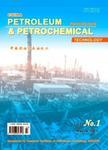Effects of Vanadium Oxidation Number on Light Olefins Selectivity of FCC Catalyst
Effects of Vanadium Oxidation Number on Light Olefins Selectivity of FCC Catalyst作者机构:SINOPEC Res Inst Petr Proc Beijing 100083 Peoples R China
出 版 物:《China Petroleum Processing & Petrochemical Technology》 (中国炼油与石油化工(英文版))
年 卷 期:2011年第13卷第2期
页 面:1-8页
核心收录:
学科分类:081705[工学-工业催化] 08[工学] 0817[工学-化学工程与技术]
主 题:FCC catalyst light olefins selectivity metal deposit oxidation number vanadium selective activization
摘 要:Effects of vanadium on light olefins selectivity of FCC catalysts were investigated with vanadium having different oxidation numbers (hereinafter abbreviated as Oxnum). Molecular modeling studies showed that vanadium with low Oxnum could affect the chemical conversion of large-size hydrocarbon molecules. However, the vanadium deposited on equilibrium catalyst bad high Oxnum because of the oxidation reaction taking place in the regenerator, so an activation method to reduce vanadium Oxnum named "selective activation" was introduced. It was proved by means of Electron Paramagnetic Resonance (EPR) and Temperature-Programmed Reduction (TPR) methods that the vanadium Oxnum was decreased, when the catalyst was activated. The molecular modeling studies are consistent well with the lab evaluation results. The light olefins selectivity of activated equilibrium catalysts was better than that achieved by the inactivated catalysts. Similar results were observed with the lab vanadium-contaminated catalyst. The light olefins selectivity of the catalyst was optimized when the vanadium Oxnum was close to 2 (VO).



